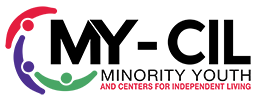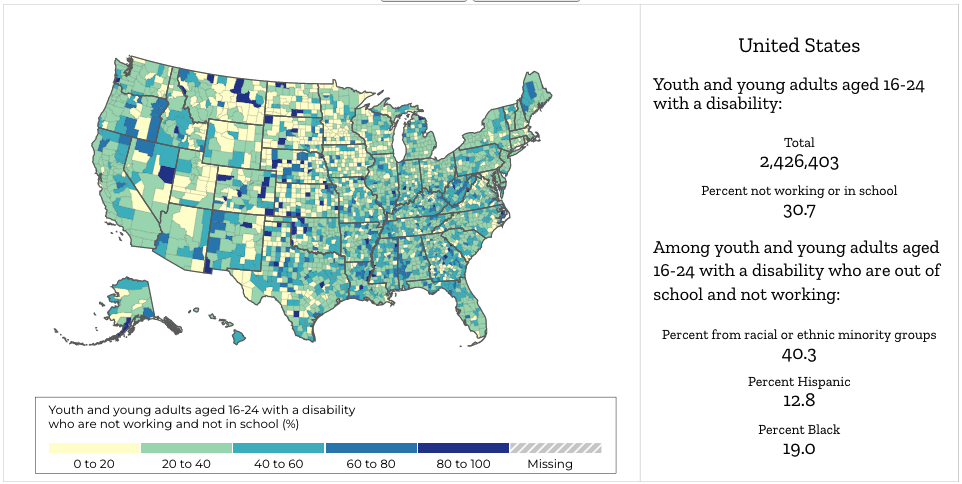Minority Youth and Centers for Independent Living

Hunter College, The City University of New York; Mathematica; Center for Independence of the Disabled New York; and Independent Living Research Utilization
Submitted by Purvi Sevak and Frank Martin
Focus
The Minority Youth and Centers for Independent Living (MY-CIL) project works to empower centers for independent living (CILs) to increase and improve services for traditionally underserved out-of-school youth and young adults with disabilities (ages 14 to 24) from racial and ethnic minority backgrounds. This Knowledge Translation (KT) Casebook entry highlights the project’s approaches to engaging end users and other key audiences, including a stakeholder advisory group that provides input on the design and execution of all research, training, and dissemination activities; learning collaboratives that promote knowledge exchange among CILs and researchers; research activities with CIL staff and young people; and partnerships with opinion leaders to build relationships with end users and consumers.
Context
CILs are community-based service organizations run by and for people with disabilities to promote the principles of independent living. CILs are also required to serve transition-age youth with disabilities. However, many youth with disabilities, especially those from minority backgrounds, face barriers in the transition to adulthood. Of further concern, many CILs encounter challenges in engaging minority youth with disabilities. MY CIL collaborates with CIL staff and youth participants to generate and share knowledge that will help improve services for traditionally underserved out-of-school youth from racial and ethnic minority backgrounds.
MY CIL is jointly funded under grant number 90DPGE0013 as a cooperative agreement between the Office of Independent Living Programs and the National Institute on Disability, Independent Living, and Rehabilitation Research, both of which are housed in the Administration for Community Living, U.S. Department of Health and Human Services. Hunter College, City University of New York, leads the project in partnership with Mathematica, the Center for Independence of the Disabled New York (CIDNY), and Independent Living Research Utilization (ILRU).
KT Activities
MY CIL uses a variety of approaches to engage and collaborate with end users and other audiences. The KT activities outlined below help ensure that the project’s outputs will be helpful to CILs. The project will apply the knowledge generated through these activities to create and test a suite of interventions codesigned with CILs to improve outcomes for out-of-school youth with disabilities from racial and ethnic minority backgrounds.
Stakeholder Advisory Group
MY CIL relies on a stakeholder advisory group to provide input on the design and execution of all research, training, and dissemination activities. The eight-member advisory group brings together CIL leadership and researchers, including individuals with disabilities, to provide diverse perspectives on the design of the project’s research and plans for KT. This approach involves end users in all stages of the project’s work, ensuring that products will be useful to CILs and the people they serve.
Crucially, the advisory group offers a structure through which people with disabilities can provide input based on their lived experience. This input has helped the project more effectively reach end users, make products more user friendly, and contextualize the project’s research findings.
Learning Collaboratives
CIL staff also participate in the project through learning collaboratives, which afford opportunities for CILs working in different contexts to learn from one another and brainstorm solutions to common challenges. To date, three cohorts of CILs have participated in learning collaboratives. Each cohort comprises six to 10 CIL teams who meet monthly, over a period of 6 to 8 months, to discuss and implement strategies to better serve out-of-school youth with disabilities from minority backgrounds. Discussions between participating CILs have shed light on many promising strategies, such as developing collaborative partnerships with agencies and other community-based organizations (Feldman et al., 2022).
 The learning collaborative approach also promotes knowledge exchange between CILs and researchers. For example, MY CIL recently developed an interactive map and downloadable data briefs to summarize demographic data about transition-age youth in CIL service delivery areas (Sevak & Hill, n.d.). While developing these products, the research team met with the learning collaborative for feedback on what kinds of measures would be helpful and how to make this information accessible to an audience with diverse learning approaches. To promote and monitor utilization, the project has continued to have conversations with CIL staff who participate in the learning collaborative about how they are using these products and about additional information that CILs would find helpful.
The learning collaborative approach also promotes knowledge exchange between CILs and researchers. For example, MY CIL recently developed an interactive map and downloadable data briefs to summarize demographic data about transition-age youth in CIL service delivery areas (Sevak & Hill, n.d.). While developing these products, the research team met with the learning collaborative for feedback on what kinds of measures would be helpful and how to make this information accessible to an audience with diverse learning approaches. To promote and monitor utilization, the project has continued to have conversations with CIL staff who participate in the learning collaborative about how they are using these products and about additional information that CILs would find helpful.
Surveys, Interviews, and Focus Groups
MY CIL surveyed all federally funded CILs in 2020 as part of the project’s needs assessment process. Survey results enabled the project team to gauge the extent to which CILs served youth and young adults with disabilities from minority backgrounds who are no longer in school (Feldman et al., 2022). The project team conducted follow-up interviews with seven CILs regarding their program services, engagement, and connections with vocational rehabilitation (VR) agencies. Besides using this research to inform project activities, MY CIL has disseminated the findings through webinars and practice briefs to make this knowledge available to the CIL community nationwide. For example, based on interviews with CILs and analyses of administrative data from VR agencies, the project recently published a practice brief on potential ways in which CILs can collaborate with VR agencies to support out-of-school youth with disabilities from minority backgrounds (Honeycutt & Martin, 2023).
MY CIL has also engaged with youth to understand their interests and independent living service needs. In 2022, the project conducted three virtual focus groups with out-of-school youth with disabilities from minority backgrounds. MY CIL disseminated findings from the youth focus groups through a webinar and three practice briefs containing recommendations for outreach strategies, sustained engagement, and CIL programs and activities (Aguillard & Wang, 2022a, 2022b, 2022c). Findings from the focus groups ultimately will help inform the design of the intervention that MY CIL is co creating with CILs.
Partnering With Opinion Leaders
MY CIL is a partnership between several organizations (see Context section) whose leadership in their respective fields undergirds the KT activities of the project. The project’s partner organizations are well positioned to reach end users and other audiences through their existing networks, thus lending the project credibility with individuals and organizations who participate in research and dissemination activities, or who make up the intended audience for these activities. We highlight two key examples of this approach:
- As a national center for information, training, research, and technical assistance in independent living, ILRU has built long-standing relationships with CILs nationwide. MY CIL draws on the ILRU program’s existing networks to build connections with end users. ILRU’s leadership role in research and outreach activities, such as interviews and webinars, helps engage CILs to participate in these activities. In addition, ILRU works with Access Living, a CIL in Chicago, to facilitate the learning collaboratives with CILs described above.
- MY CIL has partnered with CILs to reach out-of-school youth with disabilities from minority backgrounds to participate in research. To recruit young people for focus groups, the project partnered with two CILs—Southern Illinois CIL and Able South Carolina—who, like CIDNY, have already established relationships with eligible young people. CIDNY also provided insight into outreach strategies for young people who are not currently served by CILs and who may be more difficult to reach.
Lessons Learned
Building trusting relationships with end users and other key parties has been crucial to encouraging their meaningful participation in the MY CIL project. In working with underserved communities, the project has found that it is important to approach engagement from an intersectional perspective. Many consumers who could benefit from CIL programs do not identify with disability groups, so they may be overlooked by standard outreach methods that promote engagement through a disability lens. Reaching a broader population requires meeting community members where they are, which may mean conducting outreach through non-disability-specific networks, especially through social media. MY CIL has worked to reduce barriers to participation in project activities, such as by offering incentives to assist with transportation and creating a supportive environment. Building relationships with end users and consumers requires substantial time, effort, and flexibility, which should be considered during the proposal stage of a project.
Contact Information
NIDILRR Project Name: Minority Youth and Centers for Independent Living (MY CIL)
Parent Organization: Hunter College, The City University of New York
Physical Address: 695 Park Avenue, New York, NY 10065-5024.
Websites:
- MY CIL: https://minorityyouthcil.com/
- Mathematica: https://www.mathematica.org/projects/minority-youth-and-centers-for-independent-living
Key Contacts: Elizabeth Cardoso, ecardoso@hunter.cuny.edu; Purvi Sevak, psevak@mathematica-mpr.com
References
- Aguillard, K., & Wang, M. (2022a). Ways CILs can conduct effective outreach to youth with disabilities from minority backgrounds: Focus group findings. (MY CIL Practice Brief #6). Mathematica. https://www.mathematica.org/publications/ways-cils-can-conduct-effective-outreach-to-youth-with-disabilities-from-minority-backgrounds-focus
- Aguillard, K., & Wang, M. (2022b). Ways CILs can sustain engagement of youth with disabilities from minority backgrounds: Focus group findings. (MY CIL Practice Brief #7). Mathematica. https://www.mathematica.org/publications/ways-cils-can-sustain-engagement-of-youth-with-disabilities-from-minority-backgrounds-focus-group
- Aguillard, K., & Wang, M. (2022c). Program and activity recommendations for CILs working with youth with disabilities from minority backgrounds: Focus group findings. (MY CIL Practice Brief #8). Mathematica. https://www.mathematica.org/publications/program-and-activity-recommendations-for-cils-working-with-youth-with-disabilities-from-minority
- Feldman, S., Sevak, P., Wang, M., & Harrison, S. (April 2022). To what extent are CILs serving out-of-school youth from minority backgrounds? (MY CIL Practice Brief #3). Mathematica. https://www.mathematica.org/publications/to-what-extent-are-cils-serving-out-of-school-youth-from-minority-backgrounds
- Honeycutt, T., & Martin, F. (2023). How do CILs and VR agencies work together? CIL-VR agency collaborations for out-of-school youth with disabilities from minority backgrounds. (MY CIL Practice Brief #9). Mathematica. https://www.mathematica.org/publications/how-do-cils-and-vr-agencies-work-together-cil-vr-agency-collaborations-for-out-of-school-youth
- Sevak, P., & Hill, A. (n.d.). Making data on minority youth more accessible to centers for Independent Living. Mathematica. https://www.mathematica.org/features/my-cil-reports
